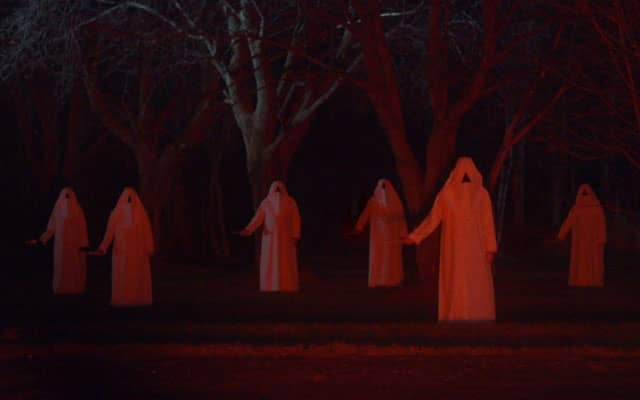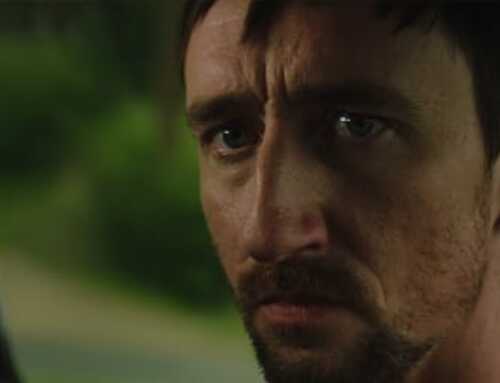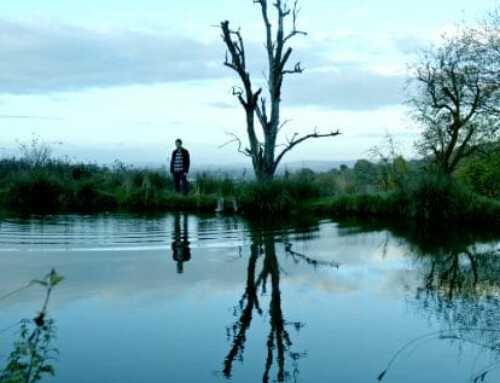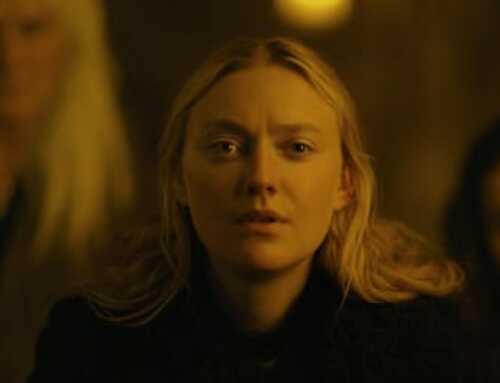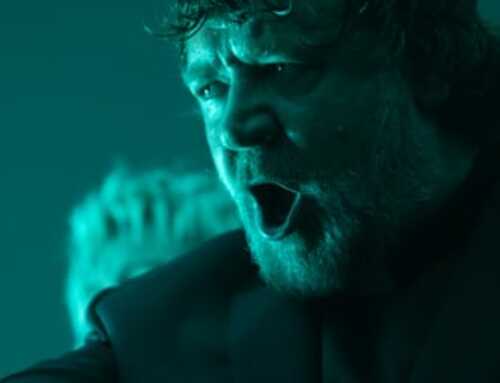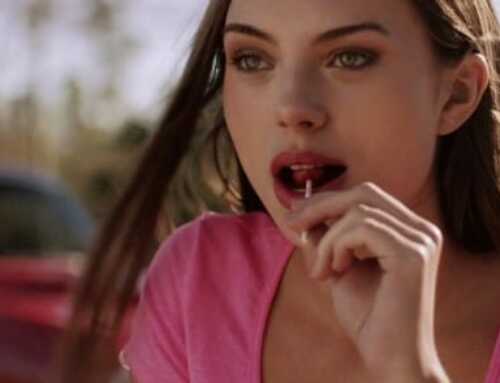
HorrorBuzz had the opportunity to chat with filmmakers Jeremy Gillespie, Steven Kostanski about the film, their process in working with one another, and yes, there is a little fanboying happening. Sorry. We fucking loved this movie.
HorrorBuzz: Where did the idea for the film come from
Jeremy Gillespie: Kind of a couple of places. In 2011 Steven and I had just finished up some other films which were more comedic in tone. We decided we wanted to try something different and maybe take a stab at straight ahead horror. I was pitching him an idea for sort of a hospital based horror movie. Personally I think hospitals are great for horror films because they are just, awful places to be. You are never in a hospital for a good reason. Then that kind of ended up getting combined with sort of a weirder more Lovecraftian, cosmic kind of horror idea and we just talked about that and grew out of there.
HB: This was one of the leanest scripts I have seen in a long time.
JG: (Laughs) Yeah it definitely didn’t start out that way. We went through a long process of writing it then scaling back what we were giving away.
Steven Kostanski: The movie was definitely a lot bigger initially.
JG: We had thought this movie was gonna be this contained, small movie which it did not end up being, it’s ridiculous how not small and contained it is. It started out with the idea of doing a movie that was restricted to one location just because we are both fans of horror and that serves horror very well. And we also tried to go easy on ourselves in terms of how much we needed to move around during shooting.
SK: The idea was to make a movie that was contained but that the story felt very expansive. Like to tell a big story in the smallest way, hint at a mythology in a contained space.
HB: What was the criteria for trimming what you didn’t need?
JG: It was a fine line in terms of practicality. We had to consider what was going to be realistic to pull off and what wasn’t. There was a LOT more stuff that had to be cut out.
SK: Yeah there was some pretty unreasonable stuff that, when we took a step back and looked at it and we were like,”Yeah how are we going to accomplish this?” It was pretty easy to determine, like “Okay, maybe some of these gags are a little too huge for our little movie.”
JG: then Narratively we went through and eliminated things because I think we both agreed that we wanted to make a thing that wasn’t exposition heavy and force feeding the audience. We wanted to make something that would be more open to interpretation to let the audience have a bigger part in the experience in a way.
SK: And also trying to keep the character stuff as simple as possible. Because we have so much weird shit going on already we kept it pretty straight forward with our characters and their character arcs, their motivations as clear as possible to counteract the weird unknowable stuff going on in the movie.
HB: A lot of it was the characters reacting to the weird things going on in the movie.
JG: Yeah We wanted to put the audience in the same space as the characters in the movie.
HB: With regards the practical effects, was that a budgetary thing or a stylistic choice?
SK: Well I mean I work in practical effects and that has been my lifelong thing. When we came up with the idea the idea was to make a monster movie and actually build them practically. The choice to go practically in a horror movie is obvious. You want things there on set that the people are interacting with and that the audience KNOWS are there because you want to sell them on the reality for it to be scary. It’s hard enough to make a scary monster movie, I don’t think it’s possible to make a scary CGI monster movie. So to have a practical creature there on camera makes a huge difference.
HB: What is your process working as co writers and co directors?
SK: I think we have pretty obvious strengths that we work with and compliment each other with and we compliment each other. This was a pretty big undertaking and I can’t imagine either one of us taking it on on our own, there are just so many moving parts.
JG: Yeah I don’t thin there was a facet of this movie that either of us weren’t getting hands on in because of the nature of the budget and the schedule. There wasn’t a part of the movie that either of us didn’t have our hands on. That was out of necessity, really. That’s sort of our background too, we love doing things ourselves.
The actual process is just a series of conversations over a period of time and we just ended up very much on the same page once we started.
SK: Yeah once we got to set it was pretty easy to divvy up the work. You know on creature heavy days I’d be doing the creature work and Jeremy would be handling the actors, and we would just divide the work depending on what the day called for. I think that it ultimately helped us a that there were two people doing things, to put out fires.
JG: Oh and there were a lot of fires.
HB: You were influence by The Thing. But are there any other cues or references hidden in the movie?
JG: Oh yeah there are plenty of references that made it to the movie that we took in over the course of our lives. I don’t think there are any direct influences. We actually tried to stay away from The Thing as much as possible. The movie was sort of born from the movies that we liked and the tone that we wanted to make. This idea of cosmic doom permitted everything.
SK: Yeah, It was like a tone that we found in a lot of literature and films and also video games that we wanted to emulate. The influences we had san multiple mediums. If anything this movie was the movie we always wanted to see but never had. Like kind of a combunation of multiple elements. It definitely fits on the shelf next to The Keep or Kurosawa’s The Cure, Prince of Darkness. Its tonally in the same realm as those films but there wasnt a direct reference in any sort of way
JG: If people see stuff in it, that’s great, that’s a nice compliment. I think the two films though that we did discuss visually when making the movie were Alien and No Country for Old Men.
SK: Yeah those were two
HB: Were you given much creative freedom or were you told what you could or could not do?
JG: I think we had a lot of freedom, in the preproduction phase at least. Once you get into the actual making of the movie you are pushing up against obstacles and things that are steering it in other directions.
SK: I think it worked in our favor that we were making such a weird, crazy movie that people were scared to challenge some of our creative decisions because we had built such a house of cards that nobody wanted to shake things up. “Oh okay there’s a guy stabbing his head into a pipe, I guess it’s okay.”
HB: Where do you see horror going?
JG: I feel like Horror has always moved in waves of trends. I don’t know, what’s the thing right now? Witches or something? and then maybe a lot of retroness
SK: In terms of the medium I think we are going into a lot of episodic content. Things like American Horror Story and The Walking Dead seem to be really popular.
JG: The danger becomes kinda like the snake eating its own tail. You have so many people being influenced by horror movies making things that are very similar to their influences. But regardless of what’s going on you always have these gems come through and those are always the movies that age well. Like Get Out. That feels like a movie that comes out of nowhere, It Follows, Green Room. Where they don’t necessarily feel like they are part a movement of horror.
SK: The Witch is a good example for sure.
HB: What is next for you guys?
JG: Getting a paycheck and working.
SK: You can expect that I am working so that I get a check so I can pay my rent. (Laughs)
JG: If The Void is somehow ultra successful financially and we make a trillion dollars, then uh, we’ll probably be doing the next Star Wars.
SK: Yeah we could make the first SCARY Star Wars movie.
JG: You heard it here first!
Okay, so you heard it here first. A scary Star Wars movie. J.J. Abrams are you listening? These talented gents are waiting. What is fascinating about the chemistry between Jeremy Gillespie, Steven Kostanski is that is is so seamless. While watching The Void, you would think that a single person wrote and directed this masterful piece of sci-fi terror, much less written.
Independent filmmakers take note. You CAN do it. You CAN make a big movie on a small budget. You CAN capture the hearts and minds of moviegoers on a shoestring. Okay, this wasn’t a shoestring budget per se but you get the idea. Work with what you have, create worlds and tell a story that reflects that world.
You can now dive into The Void on iTunes and Amazon.
| The Void | ||
| RATING: | R | |
| Runtime: | 1hr. 30Mins. | |
| Directed By: | ||
| Written By: | ||


